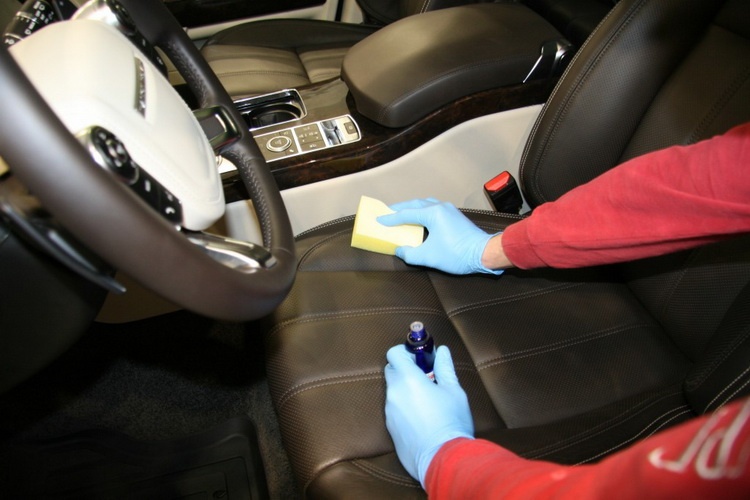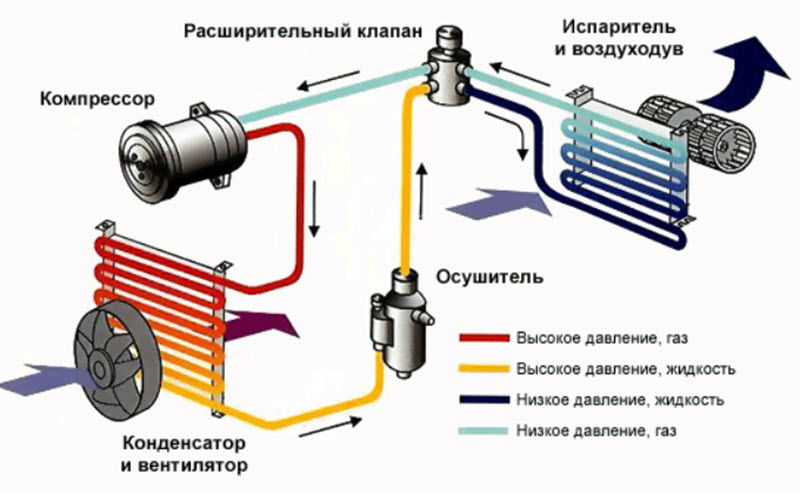
How to check the pressure in the car air conditioner yourself
Content
The air conditioning system has become an integral part of any modern car. It allows you to maintain an optimal temperature regime in the passenger compartment of the car, regardless of external temperature fluctuations. The uninterrupted operation of the presented system largely depends on maintaining the set parameters under various operating conditions. One of these parameters is the pressure of the refrigerant. In the event that the presented value does not correspond to the declared value, the system ceases to function normally.
In order to prevent or at least reduce the risk of emergencies, it is necessary to carry out regular maintenance, including a number of preventive measures.

It often happens that the driver, due to his ignorance, is not able to perform such actions. To do this, it is necessary to master at least a minimum set of skills and abilities, as well as to understand the principle of the system as a whole.
The basics of the air conditioner in the car
In order to take active steps to diagnose or eliminate the malfunction of the air conditioner, it is important to understand the basic principles of the operation of this system.
Referring to various competent sources, we can say that the presented systems were installed on cars at the beginning of the last century. Of course, over time, technological progress has made it possible to significantly improve such climate systems. Science-intensive technologies have helped make systems more compact and energy-intensive, but they are based on almost the same principles.
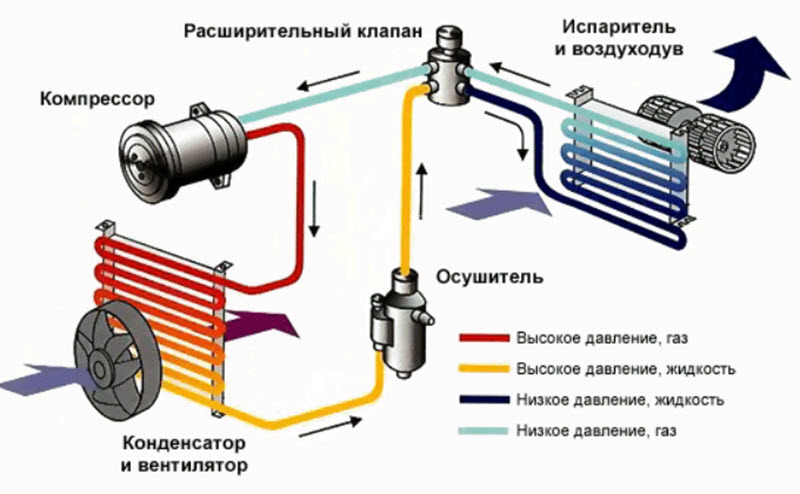
The presented climate system is completely sealed. It consists of two circuits in which one can observe the transition of the working substance - freon - from one chemical state to another. In one of the circuits there is a low pressure area, in the other high.
The compressor is located at the boundary of these two zones. Speaking figuratively, it can be called the heart of the system, which ensures the circulation of the refrigerant inside a closed circuit. But on one compressor "you won't go far." Let's start in order, from the moment the climate control key is turned on.
When the air conditioning system is turned on, the compressor drive electromagnetic clutch is activated. Torque from the internal combustion engine is transmitted to the compressor. He, in turn, begins to suck in freon from the low pressure area and pumps it into the high pressure line. As the pressure increases, the gaseous refrigerant begins to noticeably heat up. Moving further along the line, the heated gas enters the so-called condenser. This node has much in common with the radiator of the cooling system.
Moving through the tubes of the condenser, the refrigerant begins to release more heat into the environment. This is largely facilitated by the condenser fan, which provides airflow depending on the various operating modes. The air flows passing through the radiator take part of the heat of the heated refrigerant. On average, the freon temperature at the output line of this node decreases by a third of its initial value.
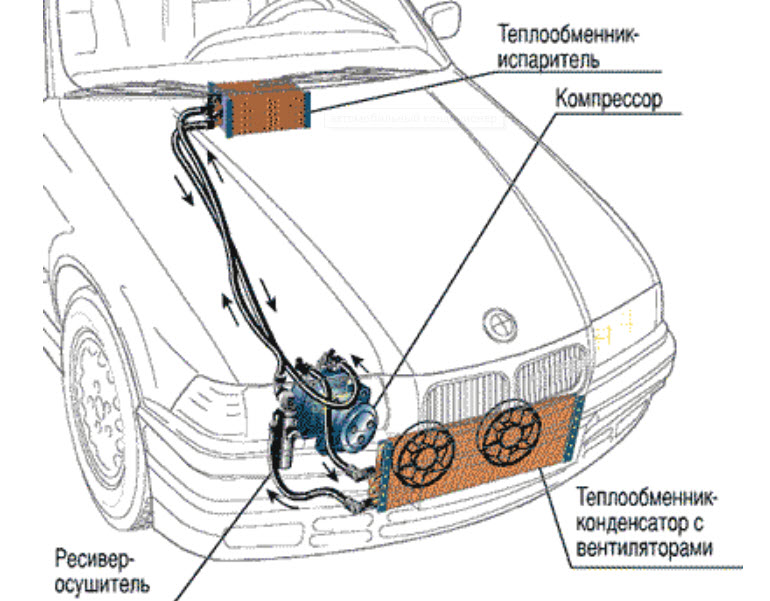

The next destination for freon is a filter drier. The name of this simple device speaks for itself. Simply put, it traps various foreign particles, preventing clogging of the system nodes. Some models of dehumidifiers are equipped with special viewing windows. With their help, you can easily control the level of refrigerant.
The filtered refrigerant then enters the expansion valve. This valve mechanism is more commonly known as an expansion valve or expansion valve. It is a dosing device that, depending on certain factors, reduces or increases the flow area of the line on the way to the evaporator. It will be appropriate to mention these factors a little later.


Watch this video on YouTube
After the expansion valve, the refrigerant is sent directly to the evaporator. Due to its functional purpose, it is often compared with a heat exchanger. The cooled refrigerant begins to circulate through the evaporator tubes. In this phase, freon begins to pass into a gaseous state. Being in a zone of low pressure, the temperature of freon drops.
Due to its chemical properties, freon begins to boil in this state. This leads to condensation of freon vapors in the heat exchanger. The air passing through the evaporator is cooled and fed into the passenger compartment with the help of an evaporator fan.
Let's get back to TRV. The fact is that an indispensable condition for the smooth operation of the air conditioning system is the continuous maintenance of the boiling process of the working fluid in the heat exchanger. As required, the valve mechanism of the expansion valve opens, thereby replenishing the working fluid in the evaporator.


At the same time, the expansion valve, due to its design features, contributes to a sharp decrease in the pressure of the refrigerant at the outlet, which entails a decrease in its temperature. Due to this, freon reaches the boiling point faster. These functions are provided by the presented device.
It is also worth mentioning the presence of at least two air conditioning sensors. One is located in the high pressure circuit, the other is embedded in the low pressure circuit. Both of them play an important role in the operation of the presented system. By sending signals to the registering device of the engine control unit, the compressor drive and the condenser cooling fan are timely turned off / on.
How to check the pressure yourself
There are frequent cases when, during the operation of a split system of a car, it becomes necessary to make a control measurement of pressure in the system circuits. With this, at first glance, a difficult task, you can successfully cope on your own, without the involvement of specialists and so-called servicemen.
All that is required for this is a couple of pressure gauges with suitable connectors. To simplify the procedure, you can use a special gauge block, which can be purchased at many car dealerships.
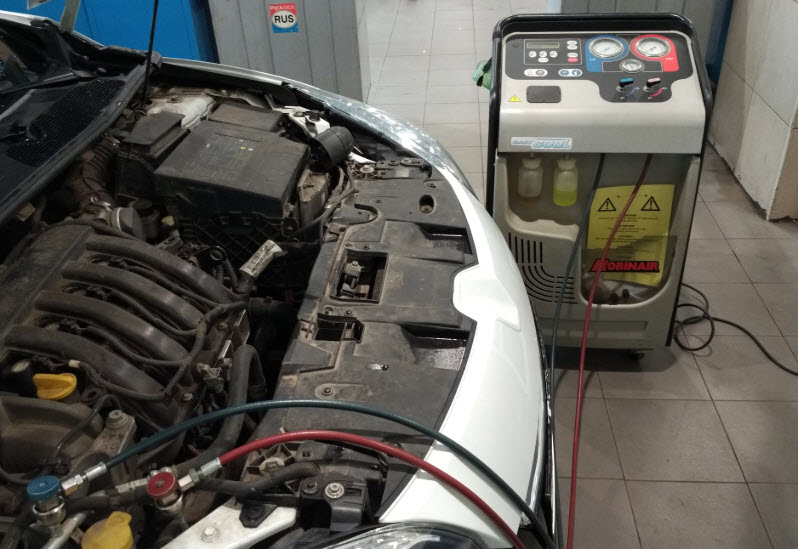

When carrying out the procedure for measuring the pressure of the air conditioning system, it is important to follow a certain sequence of actions:
- remove the plug from the system line;
- screw the manometric station, avoiding the ingress of dust particles and debris into the system;
- start the engine and check the performance.
Depending on the ambient temperature and refrigerant label, the operating pressure for each circuit will vary.
For example, for freon R134a, at a temperature of +18 to +22 degrees, the optimal pressure value is:
- in the low pressure circuit - from 1,8 to 2,8 kg / cm2;
- in the high pressure circuit - from 9,5 to 11 kg/cm2.
For a more detailed analysis of the presented indicators, you can use the summary tables available on the network.


By comparing the obtained data with the set values, one can be convinced of insufficient or excessive pressure in the air conditioning system.
According to the results of the check, it is possible to draw certain conclusions about the health of a particular node of the system. It should be noted that the identified parameters in no way indicate an insufficient amount of refrigerant in the system. To do this, you need to measure the temperature of the working fluid.
Video check
We bring to your attention a video material dedicated to the diagnosis of air conditioner malfunctions based on the readings of the manometric unit.


Watch this video on YouTube
What pressure should be and how to fill the air conditioner after checking
The pressure in the various circuits of the system depends on a number of factors. As noted earlier, this indicator is largely affected by air temperature and the type of working fluid.
One way or another, for the most part, modern air conditioning systems, as a rule, are charged with universal types of refrigerants that have similar operating parameters. The most common of these is the so-called 134 freon.
So, in warm weather, this type of refrigerant should be in the air conditioning system under pressure equal to:
- 12 - 15 kg / cm2 in the high pressure circuit;
- 1,5 - 5 kg / cm2 in the low pressure circuit.
It must be remembered that this is one of the key performance characteristics of the car's climate systems. It allows you to judge the health of its working units and elements.
Be sure to read: How to repair a crack in a plastic bumper
The procedure for measuring the pressure of the air conditioner often leads to a loss of refrigerant. In this regard, it becomes necessary to replenish the system to the required value.
To refuel the system, you must have some equipment with you. The equipment list includes:
- manometric block;
- a pair of air conditioning hoses;
- reservoir with working fluid;
- transition fittings with shutoff valves.
Even a novice motorist will be able to cope with refueling the system with freon, you just have to follow the step-by-step instructions:
- screw the fitting with a tap to the freon tank;
- connect the fitting to the hose;
- connect the other end of the hose to the manometric station;
- mount the remaining hose with a fitting on the other output of the manometric block;
- proceed directly to refueling the system by opening the tap.


Watch this video on YouTube
To find out the filling capacity of the air conditioning system of a particular car, just look at the information plate under the hood of your car. After studying it, you will find out the type / brand of working fluid and the volume of the system.
Causes of low pressure + video on repairing damaged system nozzles
One of the common problems that owners of cars with air conditioning face is a decrease in pressure in the system. The reasons for this kind of situation can be very different.
Consider the main ones:
- malfunction of the electromagnetic clutch of the compressor;
- blown fuse for the drive clutch or air conditioning fan;
- malfunction of the working fluid pressure sensor;
- malfunctions in the operation of the TRV;
- reduced compressor performance;
- insufficient amount of refrigerant in the system;
- depressurization of the system.


The last point indicates that there is a freon leak in one of the connections. Often this kind of reasons are associated with the wear of the pipes of the air conditioning system. Considering the fact that new original components will cost the owner a fairly tidy sum, you can use one of the methods to restore the hoses and pipes of the air conditioner in garage conditions.
For more information on repairing car split system hoses, see the video below.


Watch this video on YouTube
The presented video was posted by a well-known Moscow service center specializing in the repair of refrigeration units and climate systems.
